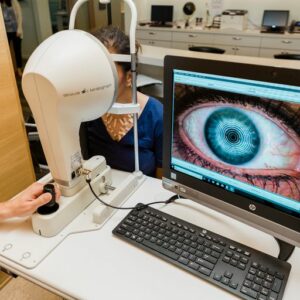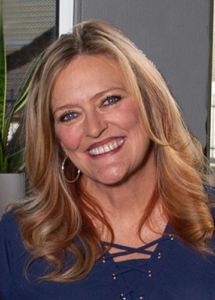
A meibographer in Dr. Sorrenson’s office. Dr. Sorrenson says that you should carefully review your medical eyecare metrics to ensure both great patient care and profitability.
Analyzing medical eyecare metrics & making changes to boost care and profitability.
By Laurie Sorrenson, OD, FAAO
Oct. 11, 2023
Alright, before we dive into this discussion, let me make one thing crystal clear: in our office, our number one priority is providing excellent eyecare to our patients. But understanding the financial side of things can help us take even better care of our patients. More profits means we can afford more staff, better training and updated new equipment to take great care of our patients.
So, I got focused (obsessive maybe?) and ran a bunch of analyses comparing Medical Office Visits, including medical tests/procedures, to the “Full Exams” or “Annual Eye Exams.” Sure, there’s some room for error and overlap, but no matter how I analyzed it, the results were surprisingly consistent. This analysis could be quite different in your office, so feel free to analyze this for yourself!
One Analysis I Used
Here’s one of the ways I analyzed it, which is also the simplest way. I added up all the “receipts” from office visits, medical tests, procedures and surgical codes for the year 2022. (I created a new sales report in Crystal Practice Management) Then, I subtracted the cost of the medical supplies associated with those procedures. If I had any monthly equipment payments, I’d have subtracted those too, but our medical equipment is all paid off (yay!). Next up, I counted the total number of office visits and divided the receipts minus supplies by that number of office visits. The result? Profit per office visit in dollars.

Then I added up the receipts for all “Full Exams,” optomap screenings, frames, spectacle lenses and contact lenses. I made sure to factor in all the discount codes we use. Then, I subtracted the Cost of Goods Sold (COGS) for frames, lenses and contact lenses. Finally, I divided that total by the number of “full exams” to get the profit per full exam.
![]()
The results? Full (annual) exams were 104 percent more profitable than an office visit. Another way to say it is that office visits turned out to be 51 percent less profitable per appointment compared to full exams. Who would’ve thought? Especially since we’re knee-deep in medical stuff like dry eyes with intense pulsed light (IPL)/low-level light therapy (LLLT), amniotic membranes, glaucoma and AMD. I also did other analyses using different ways of calculating, but the results were very similar.
But why did I put myself through all this number-crunching? Well, one, to keep providing “WOW” eyecare, we have to be profitable. Finding ways to boost our office’s profitability per appointment and per hour is key to be able to continue to invest in the practice to be able to “WOW” our patients.
One big caveat here… if you’re a newer practice that’s not booked a week or more in advance, here’s a tip: always pre-appoint your patients and don’t hesitate to slot in those office visits. A less profitable office visit is still WAY better than that appointment slot being empty.
Improve Profitability Per Appointment Slots/Hour
Here’s another thought on improving profitability per appointment slot or per hour– analyze the need for contact lens follow-ups. Can your techs be trained to handle some or most of those for the doctor? That may be an opportunity to increase your hourly profits. Unnecessary follow-up care for contacts, or anything else, decreases profitability and most patients don’t want to come to the office when it isn’t necessary. Also, any time you can delegate to your staff and be able to take a visit off your schedule will be empowering for your staff AND increase your profitability per hour and per appointment.
Other Articles to Explore
Another option I have seen some doctors implement is to schedule medical “office visits” in shorter time periods to boost their hourly profitability. They might schedule 10 minutes for a glaucoma follow-up instead of 20.
Another way to improve profitability per hour and per appointment is to have more technology and use it. We invested in technology to better take care of our patients IPL/LLLT/LipiFlow, AdaptDx, BlephEx, fundus photos, anterior segment photos, meibomian gland imaging, B-Scan, specular microscopy, amniotic membranes, ocular response analyzer, visual fields, OCT and ERG.
Case in point: A run-of-the-mill six-month glaucoma visit with just Goldmann and an office visit might bring in less than $100. But if you’ve got the technology with visual fields, ocular response analyzer, OCT and ERG, that visit could easily bring in over $250. Doubling or tripling your gross revenue per visit for a glaucoma visit is huge.
To set the record straight, I’m not saying we should ditch medical care or ignore “medical optometry.” Nope, I’m about becoming more profitable so that we can take even better care of our patients. 😉
 Laurie Sorrenson, OD, FAAO, is president of Lakeline Vision Source in Cedar Park, Texas, and the Professional Editor of Review of Optometric Business (ROB). To contact her: lsorrenson@gmail.com.
Laurie Sorrenson, OD, FAAO, is president of Lakeline Vision Source in Cedar Park, Texas, and the Professional Editor of Review of Optometric Business (ROB). To contact her: lsorrenson@gmail.com.























